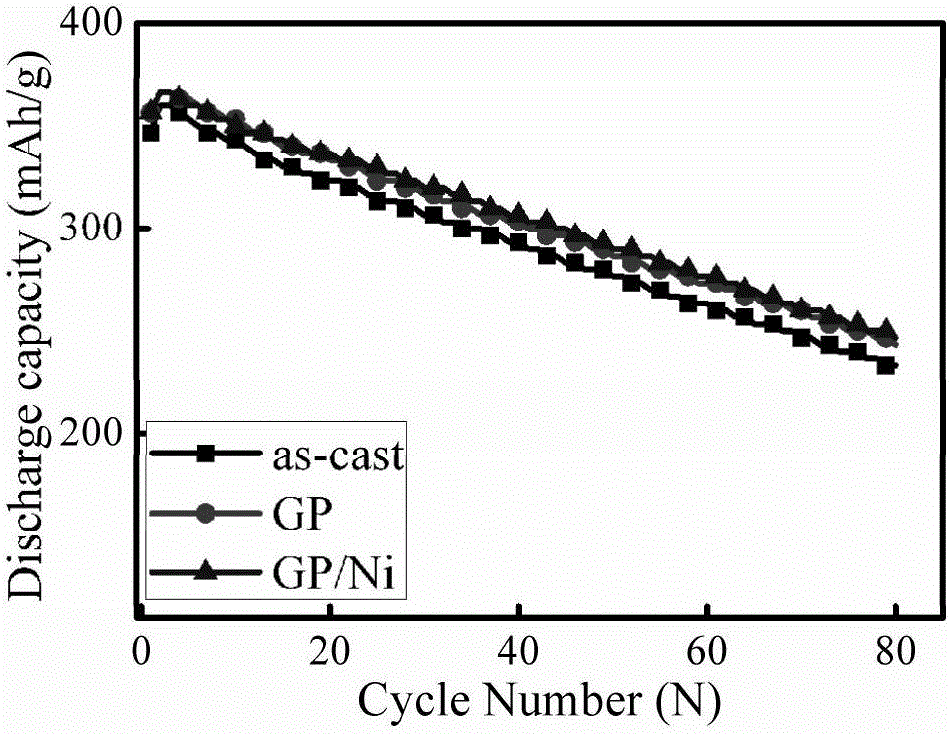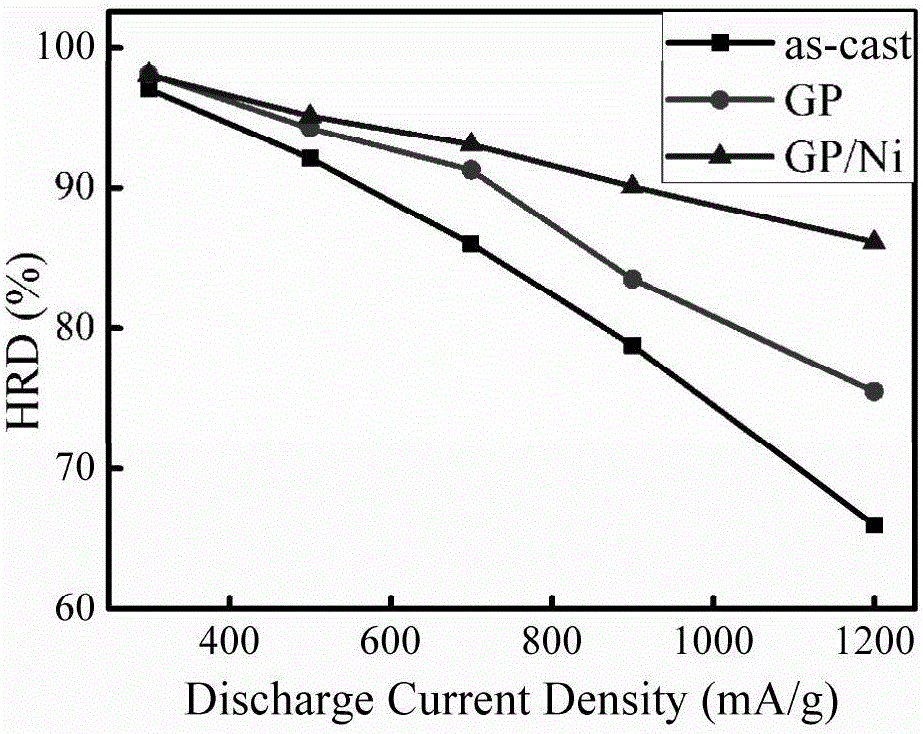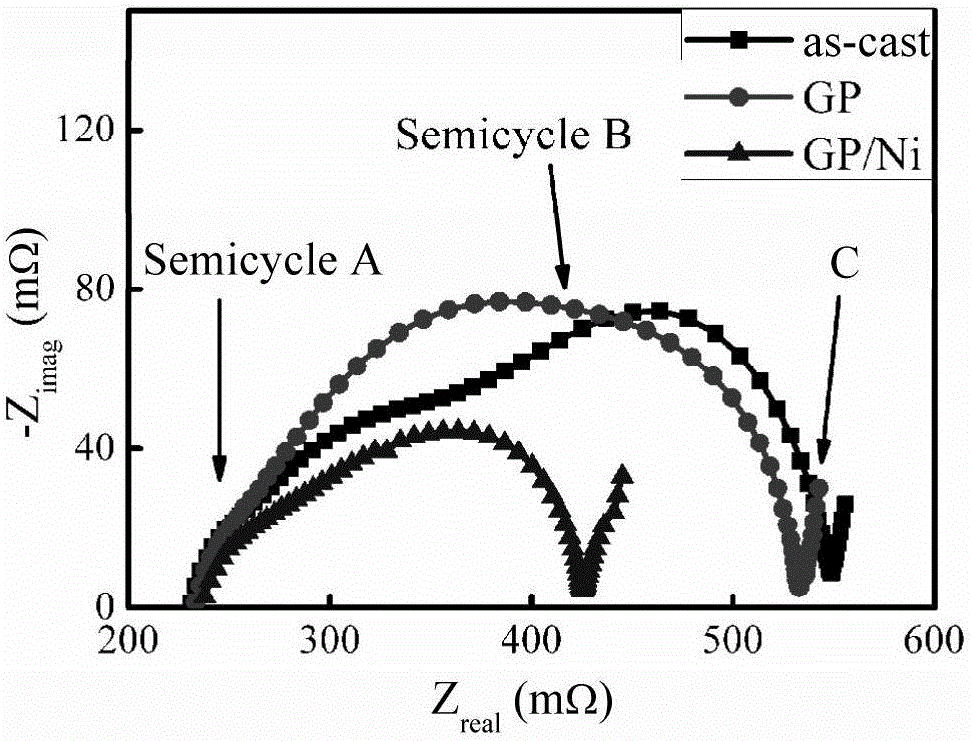Method for improving electrochemical and dynamic properties of La-Mg-Ni-based alloy electrode
An electrochemical and alloy-based technology, applied in battery electrodes, circuits, electrical components, etc., can solve the problems of decreased electrochemical kinetic performance, decreased cycle stability, and limited development of Ni-MH batteries, and achieves improved electrochemical performance. Kinetic properties, the effect of reducing electrochemical impedance
- Summary
- Abstract
- Description
- Claims
- Application Information
AI Technical Summary
Problems solved by technology
Method used
Image
Examples
Embodiment 1
[0022] A method for improving the electrochemical kinetic performance of a La-Mg-Ni base alloy electrode, the preparation steps are as follows:
[0023] 1. Preparation of La-Mg-Ni based alloy
[0024] Under the protection of argon, the samples are configured according to the molar ratio of La:Mg:Ni:Co=7:3:29.75:5.25. All raw materials are block samples, and Mg is the master alloy MgNi 2 Instead, at the same time, in order to reduce the Mg element lost due to volatilization in the smelting process, an additional mass fraction of 20% MgNi 2 , deduction of MgNi 2 After adding Ni in the alloy, add elemental Ni to ensure that the ratio requirements are met, and then use the magnetic levitation induction melting method to melt the material. In order to ensure uniform smelting, the alloy ingot was repeatedly turned and smelted three times. Then part of the alloy is crushed and passed through a 250 mesh sieve, and then divided into three parts.
[0025] 2. Preparation of La-Mg-Ni-...
Embodiment 2
[0028] A method for improving the electrochemical kinetic performance of a La-Mg-Ni base alloy electrode, the preparation steps are as follows:
[0029] 1. La-Mg-Ni based alloy preparation:
[0030] Under the protection of argon, the samples are configured according to the molar ratio of La:Mg:Ni:Co=7:3:29.75:5.25. All raw materials are block samples, and Mg is the master alloy MgNi 2 Instead, at the same time, in order to reduce the Mg element lost due to volatilization in the smelting process, an additional mass fraction of 20% MgNi 2 , deduction of MgNi 2 After adding Ni in the alloy, add elemental Ni to ensure that the ratio requirements are met, and then use the magnetic levitation induction melting method to melt the material. In order to ensure uniform smelting, the alloy ingot was repeatedly turned and smelted three times. Then part of the alloy is crushed and passed through a 250 mesh sieve, and then divided into three parts.
[0031] 2. Preparation of La-Mg-Ni / gr...
Embodiment 3
[0034] A method for improving the electrochemical kinetic performance of a La-Mg-Ni base alloy electrode, the preparation steps are as follows:
[0035] 1. La-Mg-Ni based alloy preparation:
[0036] Under the protection of argon, the samples are configured according to the molar ratio of La:Mg:Ni:Co=7:3:29.75:5.25. All raw materials are block samples, and Mg is the master alloy MgNi 2 Instead, at the same time, in order to reduce the Mg element lost due to volatilization in the smelting process, an additional mass fraction of 20% MgNi 2 , deduction of MgNi 2 After adding Ni in the alloy, add elemental Ni to ensure that the ratio requirements are met, and then use the magnetic levitation induction melting method to melt the material. In order to ensure uniform smelting, the alloy ingot was repeatedly turned and smelted three times. Then part of the alloy is crushed and passed through a 250 mesh sieve, and then divided into three parts.
[0037] 2. The steps of the La-Mg-Ni / ...
PUM
| Property | Measurement | Unit |
|---|---|---|
| Diameter | aaaaa | aaaaa |
| Thickness | aaaaa | aaaaa |
| Maximum discharge capacity | aaaaa | aaaaa |
Abstract
Description
Claims
Application Information
 Login to View More
Login to View More - R&D
- Intellectual Property
- Life Sciences
- Materials
- Tech Scout
- Unparalleled Data Quality
- Higher Quality Content
- 60% Fewer Hallucinations
Browse by: Latest US Patents, China's latest patents, Technical Efficacy Thesaurus, Application Domain, Technology Topic, Popular Technical Reports.
© 2025 PatSnap. All rights reserved.Legal|Privacy policy|Modern Slavery Act Transparency Statement|Sitemap|About US| Contact US: help@patsnap.com



